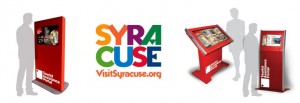Imagine Syracuse at your fingertips.
That’s what will happen with a new system of kiosks scattered between downtown and Hancock International Airport, say tourism officials.
“The system is dynamic and highly visual,” said David Holder, president of the Syracuse Convention and Visitors Bureau. “It catches a person’s eye no matter what.”
The tourism bureau is negotiating with a technology-design company, BlueFocus Media, to provide the kiosks as early as summer 2013. The bureau hopes to finalize a contract by mid-March, said Holder.
The kiosks are called the Tourist Assistant Portal, or TAP. The Convention and Visitors Bureau wants between ten and 20 to spread between downtown and the airport, Holder said.
The system will solve a major problem for visitors, said Holder. “We don’t have a lot of available information for our guests coming into town,” he said.
Right now, the Convention and Visitors Bureau is looking at an initial investment of $115,000-$140,000, Holder said. The Connective Corridor will pay for the units and installation fees, Holder said, with the Convention and Visitors Bureau paying for the yearly maintenance.
The kiosks cost between $6,000-$10,000 per unit, said Nick Lucey, the account executive at BlueFocus Media. Each kiosk comes with a touch-screen interface. The $6,000 kiosk is a 24-inch upright panel. The $10,000 unit has a 42-inch high-definition screen. The screens are enclosed in an aircraft-grade aluminum stand.
“It’s virtually vandalism-proof,” Lucey said. “It’s more than just a computer monitor sitting on a desk.”
On the screen, visitors will see every business in the Convention and Visitors Bureau’s database, Lucey said. Each business starts out with a basic listing with a name, address and phone number. If a business wants to upgrade its listing, it can pay a fee for more interactive features such as a photo book and different deals through the kiosk.
“It’s like having a website, so to speak, on the system,” Lucey said.
The kiosks are always connected to the Internet through a cable connection, Wi-Fi connection or from a cellular network, Lucey said. “Our system is always up,” he said.
The kiosks will also save paper by replacing tourism pamphlets with the “very brilliant high-definition screen,” said Lucey. “It adds a totally different dimension to the visitors center experience and reducing a lot of that paper waste,” he said.
Iris Stein, the head graphic designer for BlueFocus Media, is a native of Liverpool. She cites her familiarity with the area as a reason the system will help tourists.
“There are so many different areas in Syracuse that a lot of people who are visiting Syracuse don’t realize,” she said. “I can see the system being able to spread visitors around Syracuse.”
Stein described the kiosk as “not just big buttons on a screen.” Instead, she said it’s more like a digital photobook. “The system,” Stein said, “is designed to make a city more user-friendly.”
(Tyler Greenawalt is a junior with dual majors in newspaper and online journalism and political science.)
-30-



